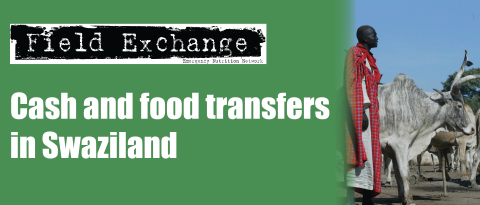Postscript to 'Fresh food vouchers for refugees in Kenya'
By Mary Lung'aho, CARE USA, and Allison Oman, UNHCR
During the period 2006 through the present, CARE, UNHCR, GTZ, IRC, NCCK and other partners have worked in an interagency collaboration (the Dadaab IYCF Team) to provide support for improved infant and young child feeding (IYCF) in the Dadaab Camps.
We would like to congratulate ACF on their efforts to improve the quality and diversity of complementary foods for young children in the Dadaab Camps.
Should the voucher programme continue, we would like to suggest that assessment at admission should be carefully conducted in collaboration with the interagency Dadaab IYCF programme to ensure that mothers of infants under 6 months are encouraged to exclusively breastfeed, that they receive skilled assistance for any difficulties they may experience, and that the voucher programme does not act as an incentive to reduce the period when an infant should exclusively breastfeed (0-<6 months).
To support this effort, we would like to further suggest that a name change be considered for the 'Weaning Babies Programme'. While the term 'weaning' appears to be used by the Dadaab voucher programme to refer to children during the period of complementary feeding, weaning can also be taken to mean the 'cessation of breastfeeding'. Breastmilk continues to contribute over half a 6- 12 month olds nutrient needs, and one-third of energy needs in a 1-2 year old - in many difficult situations, breastmilk may be amongst the best quality foods that a child receives. To stress the importance of the addition of complementary foods rather than the process of stopping breastfeeding, the programme might be renamed to reflect this (e.g. Programme for Complementary Feeding of Young Children, Complementary Feeding Children's Programme).
The authors mention tracking household dietary diversity using 10 food groups. We would like to recommend that the collection of data on dietary diversity also provides an opportunity to examine the improvement IYCF practices using the 2008 interagency (WHO, UNICEF, IFPRI, UC Davis, AED/FANTA and USAID) IYCF indicators. This would allow comparison of the results of this programme with the data collected on IYCF practices during the annual nutrition survey in Dadaab, as well as with data on IYCF practices in other camps and settings.
The indicator 'minimum dietary diversity' looks at the proportion of children 6- <24 months who receive foods from 4 or more food groups (the 7 food groups defined for the tabulation of the complementary feeding indicators are: grains, roots and tubers; legumes and nuts; dairy products (milk, yogurt, cheese); flesh foods (meat, fish, poultry and liver/organ meats); eggs; vitamin-A rich fruits and vegetables; other fruits and vegetables. Consumption of any amount of food from each food group is sufficient to 'count' (i.e. there is no minimum quantity, except if a food item is used only as a condiment).
The cut-off of at least 4 of the 7 groups was selected because it is associated with better quality diets for both breastfed and non-breastfed children. Consumption of foods from at least 4 groups on the previous day would mean that, in most populations, the child had a high likelihood of consuming at least one animal-source food and at least one fruit or vegetable that day, in addition to a staple food (grain, root or tuber).
While financial shortfalls are often a reality, we would like to support the idea that in the Dadaab refugee camp setting, all children 6-<24 months would benefit from access to additional complementary foods. There is no food in the current ration basket that fully addresses the nutrient needs and food habits of this group, though UNHCR and WFP are working to identify additional foods appropriate for this group as a parallel programme to the general ration. The yearly nutritional surveys in the camps show that the 6-<24m age group has the highest rates of global acute malnutrition, iron-deficiency anaemia and stunting. There is now compelling evidence that the consumption of animal proteins in addition to required nutrients can prevent and reverse the effects of stunting on this age group. There are no animal protein foods provided in the general ration, and so these vouchers represent one avenue of providing these.
In terms of sustainability, it is not realistic to suggest that the food voucher programme could ever be fully sustainable since it is a 'give-away' programme. UNHCR will seek support from donors (such as the French Government who were generous with the above programme) in order to continue the scheme in 2009 and beyond.
For more information on the Dadaab IYCF programme, contact: Mary Lung'aho, email: mary@nutritionpolicypractice.org or Allison Oman, email: OMAN@unhcr.org
Indicators for Assessing Infant and Young Child Feeding Practices. Part 1 Definitions. Conclusions of a consensus meeting held 6-8 November 2007 in Washington, DC, USA 2008 Published by World Health Organisation. Available to download at www.ifpri.org/pubs/cp/childfeeding.asp or from www.who.int and search in 'publications'
Imported from FEX website


